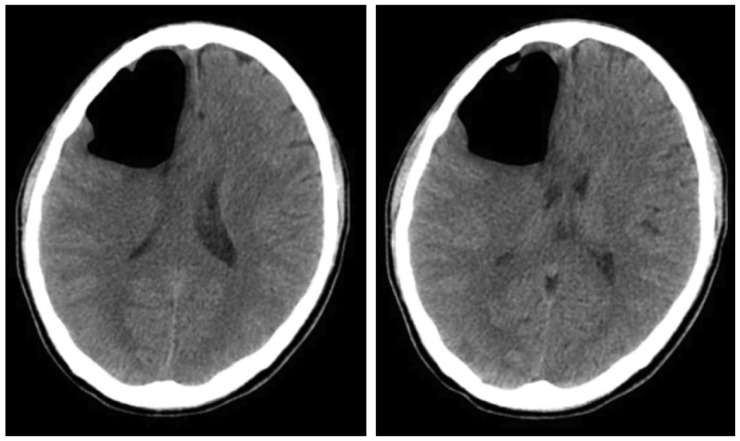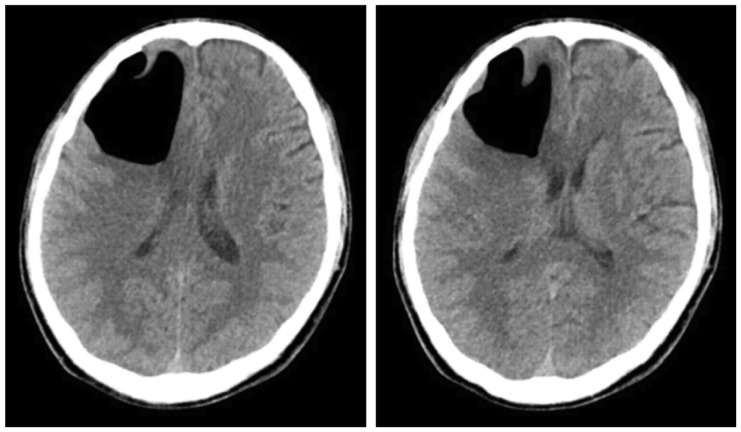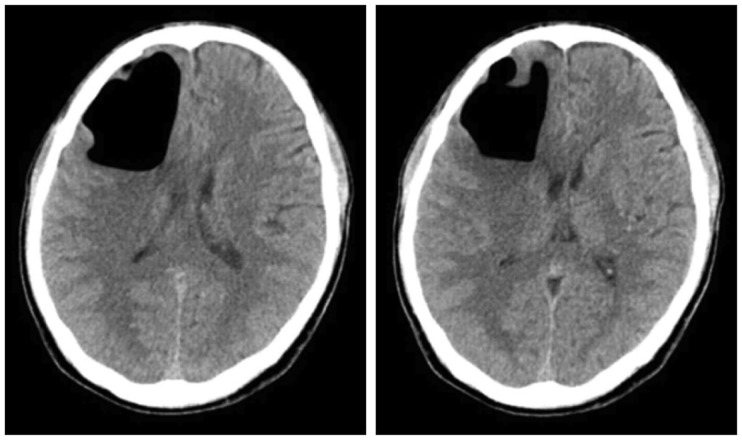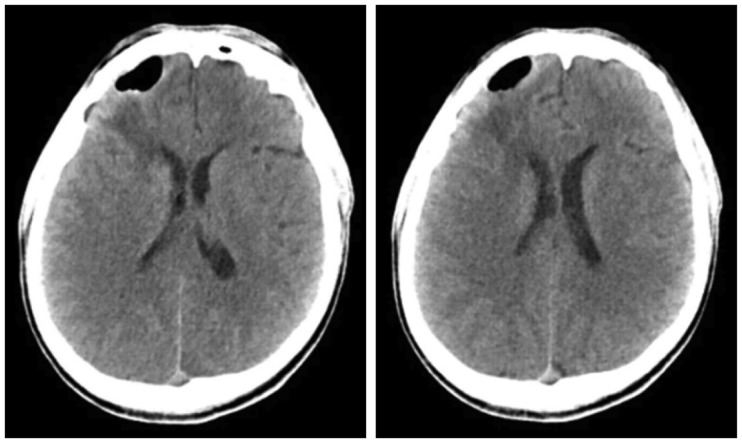Korean J Neurotrauma.
2017 Oct;13(2):158-161. 10.13004/kjnt.2017.13.2.158.
Proper Management of Posttraumatic Tension Pneumocephalus
- Affiliations
-
- 1Department of Neurosurgery, Yeouido St. Mary's Hospital, The Catholic University College of Medicine, Seoul, Korea. plo19@hanmail.net
- KMID: 2394553
- DOI: http://doi.org/10.13004/kjnt.2017.13.2.158
Abstract
- Pneumocephalus is commonly seen after craniofacial injury. The pathogenesis of pneumocephalus has been debated as to whether it was caused by ball valve effect or combined episodic increased pressure within the nasopharynx on coughing. Discontinuous exchange of air and cerebrospinal fluid due to "inverted bottle" effect is assumed to be the cause of it. Delayed tension pneumocephalus is not common, but it requires an active management in order to prevent serious complication. We represent a clinical case of a 57-year-old male patient who fell down from 3 m height, complicated by tension pneumocephalus on 5 months after trauma. We recommend a surgical intervention, but the patient did not want that so we observe the patient. The patient was underwent seizure and meningitis after 7 months after trauma, he came on emergency room on stupor mentality. Tension pneumocephalus may result in a neurologic disturbance due to continued air entrainment and it significantly the likelihood of intracranial infection caused by continued open channel. Tension pneumocephalus threat a life, so need a neurosurgical emergency surgical intervention.
MeSH Terms
Figure
Reference
-
1. Al-Aieb A, Peralta R, Ellabib M, El-Menyar A, Al-Thani H. Traumatic tension pneumocephalus: Two case reports. Int J Surg Case Rep. 2017; 31:145–149. PMID: 28152490.
Article2. Bakay L, Glasauer FE. Head injury. Boston, MA: Little, Brown;1980.3. Dabdoub CB, Salas G, Silveira Edo N, Dabdoub CF. Review of the management of pneumocephalus. Surg Neurol Int. 2015; 6:155. PMID: 26500801.
Article4. Dandy WE. Pneumocephalus (intracranial pneumatocele or aerocele). Arch Surg. 1926; 12:949–982.5. Eljamel MS, Foy PM. Post-traumatic CSF fistulae, the case for surgical repair. Br J Neurosurg. 1990; 4:479–483. PMID: 2076209.
Article6. Horowitz M. Intracranial pneumocoele. an unusual complication following mastoid surgery. J Laryngol Otol. 1964; 78:128–134. PMID: 14126276.7. Hubbard JL, McDonald TJ, Pearson BW, Laws ER. evolving concepts in diagnosis and surgical management based on the Mayo Clinic experience from 1970 through 1981. Neurosurgery. 1985; 16:314–321. PMID: 3982609.8. Kankane VK, Jaiswal G, Gupta TK. Posttraumatic delayed tension pneumocephalus: Rare case with review of literature. Asian J Neurosurg. 2016; 11:343–347. PMID: 27695534.
Article9. Komolafe EO, Faniran EA. Tension pneumocephalus: A rare but treatable cause of rapid neurological deterioration in traumatic brain injury: A case report. Afr J Neurol Sci. 2010; 29:88–91.10. Kon T, Hondo H, Kohno M, Kasahara K. Severe tension pneumocephalus caused by opening of the frontal sinus by head injury 7 years after initial craniotomy--case report. Neurol Med Chir (Tokyo). 2003; 43:242–245. PMID: 12790283.
Article11. Lunsford LD, Maroon JC, Sheptak PE, Albin MS. Subdural tension pneumocephalus. Report of two cases. J Neurosurg. 1979; 50:525–527. PMID: 423011.13. Park JI, Strelzow VV, Friedman WH. Current management of cerebrospinal fluid rhinorrhea. Laryngoscope. 1983; 93:1294–1300. PMID: 6621228.
Article14. Satapathy GC, Dash HH. Tension pneumocephalus after neurosurgery in the supine position. Br J Anaesth. 2000; 84:115–117. PMID: 10740562.
Article15. Vitali AM, le Roux. A case report. Indian J Neurotrauma. 2007; 4:115–118.






